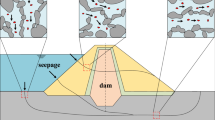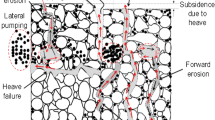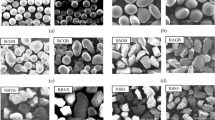Abstract
Whether the critical state friction angle of granular materials depends on grading is a fundamental question of both academic and practical interest. The present study attempts to address this question through a specifically designed experimental program where the influence of particle grading was carefully isolated from other influencing factors. The laboratory experiments show that under otherwise similar conditions, the angle of friction at critical state is a constant independent of grading, but, for a given grading, the angle of friction at critical state is highly dependent on particle shape. This finding suggests that the commonly adopted practice of separately allowing for the effect of particle shape and the effect of grading on critical state friction angle is conceptually inappropriate and, hence, should be taken with caution in geotechnical design to avoid the risk of underestimating safety requirements. The study also reveals that varying particle gradation can impose a marked impact on liquefaction susceptibility of granular soils: Under the same post-consolidation state in terms of void ratio and confining pressure, a well-graded soil tends to be more susceptible to liquefaction than a uniformly graded soil. This variation of liquefaction susceptibility is shown to be consistent with the variation of location of the critical state locus in the compression space and is explainable by the critical state theory.















Similar content being viewed by others

References
Been K, Jefferies MG (1985) A state parameter for sands. Géotechnique 35(2):99–102
Bolton MD (1986) The strength and dilatancy of sands. Géotechnique 36(1):65–78
Bolton MD (1996) Geotechnical design of retaining walls. The Struct Eng 74(21):365–369
BSI (2015) Code of practice for earth retaining structures. BS 8002: 2015, The British Standards Institution, UK
Castro G, Enos JL, France JW, Poulos SJ (1982) Liquefaction induced by cyclic loading. Rep. No. NSF/CEE-82018, National Science Foundation, Washington, DC
Cavarretta I, Coop M, O’Sullivan C (2010) The influence of particle characteristics on the behaviour of coarse grained soils. Géotechnique 60(6):413–423
Cho G, Dodds J, Santamarina JC (2006) Particle shape effects on packing density, stiffness and strength: natural and crushed sands. J Geotech Geoenviron Eng ASCE 132(5):591–602
Chu J, Lo SCR (1993) On the measurement of critical state parameters of dense granular soils. Geotech Test J 16(1):27–35
Dafalias YF (2016) Must critical state theory be revisited to include fabric effects? Acta Geotech 11:479–491
Fourie AB, Tshabalala L (2005) Initiation of static liquefaction and the role of K0 consolidation. Can Geotech J 42(3):892–906
Ishihara K (1993) Liquefaction and flow failure during earthquakes. Géotechnique 43(3):349–415
Kokusho T, Hara T, Hiraoka R (2004) Undrained shear strength of granular soils with different particle gradations. J Geotech Geoenviron Eng ASCE 130(6):621–629
Krumbein WC, Sloss LL (1963) Stratigraphy and sedimentation, 2nd edn. Freeman, San Francisco
Lambe TW, Whitman RV (1969) Soil mechanics. John Wiley & Sons, New York
Luo XD (2016) Investigation of the mechanical behaviour of granular materials: effects of particle size distribution and particle shape. Ph.D. Thesis, The University of Hong Kong
Luo XD, Yang J (2013) Effects of fines on shear behaviour of sand: A DEM analysis. In: proceedings 5th young geotech engineers’ conference, IOS Press, p 265–268
Mitchell JK, Soga K (2005) Fundamentals of soil behavior, 3rd edn. John Wiley & Sons, New Jersey
Poulos SJ, Castro G, France JW (1985) Liquefaction evaluation procedure. J Geotech Engng Div ASCE 111(6):772–792
Powers MC (1953) A new roundness scale for sedimentary particles. J Sediment Res 23(2):117–119
Riemer MF, Seed RB, Nicholson PG, Jong HL (1990) Steady state testing of loose sands: limiting minimum density. J Geotech Eng ASCE 116(2):332–337
Rouse PC, Fannin RJ, Shuttle DA (2008) Influence of roundness on the void ratio and strength of uniform sand. Géotechnique 58(3):227–231
Sadrekarrimi A, Olson SM (2011) Critical state friction angle of sands. Géotechnique 61(9):771–783
Santamarina JC, Cho GC (2001) Determination of critical state parameters in sandy soils–simple procedure. Geotech Testing J 24(2):185–192
Robertson PK, Sasitharan S, Cunning JC, Sego DC (1995) Shear-wave velocity to evaluate in situ state of Ottawa sand. J Geotech Eng ASCE 121(3):262–273
Sasitharan S, Robertson PK, Sego DC, Morgenstern NR (1994) State-boundary surface for very loose sand and its practical implications. Can Geotech J 31:321–334
Schofield AN, Wroth CP (1968) Critical state soil mechanics. McGraw-Hill, London
Simoni A, Houlsby GT (2006) The direct shear strength and dilatancy of sand-gravel mixtures. Geotech Geological Eng 24(3):523–549
Simonini P, Ricceri G, Cola S (2007) Geotechnical characterization and properties of Venice lagoon heterogeneous silts. In: proceedings 2nd international workshop characterization engineering properties natural soils, Singapore, p 2289–2328
Sladen JA, D’hollander RD, Krahn J (1985) The liquefaction of sands, a collapse surface approach. Can Geotech J 22(4):564–578
Sympatec (2008) Windox-operating instructions release 5.4.1.0, Sympatec GmbH, Clausthal-Zellerfeld, Germany
Taylor DW (1948) Fundamentals of soil mechanics. John Wiley & Sons, New York
Thevanayagam S, Shenthan T, Mohan S, Liang J (2002) Undrained fragility of clean sands, silty sands, and sandy silts. J Geotech Geoenviron Eng ASCE 128(10):849–859
Vaid YP, Chern JC (1985) Cyclic and monotonic undrained response of sands. Adv Art of Test Soils Under Cycl Load Cond ASCE, 171–176
Verdugo R, Ishihara K (1996) The steady state of sandy soils. Soils Founds 36(2):81–91
Wadell H (1932) Volume, shape, and roundness of rock particles. J Geol 40(5):443–451
Wei LM, Yang J (2014) On the role of grain shape in static liquefaction of sand-fines mixtures. Géotechnique 64(9):740–745
Wood DM (1990) Soil behavior and critical state soil mechanics. Cambridge University Press, Cambridge
Wood DM, Maeda K (2008) Changing grading of soil: effect on critical states. Acta Geotech 3(1):3–14
Xie YH, Yang ZX, Barreto D, Jiang MD (2017) The influence of particle geometry and the intermediate stress ratio on the shear behavior of granular materials. Granular Matter 19:35
Yan WM, Dong J (2011) Effect of particle grading on the response of an idealized granular assemblage. Int J Geomech 11(4):276–285
Yang J (2002) Non-uniqueness of flow liquefaction line for loose sand. Géotechnique 52(10):757–760
Yang J, Li XS (2004) State-dependent strength of sands from the perspective of unified modeling. J Geotech Geoenviron Eng ASCE 130(2):186–198
Yang J, Luo XD (2015) Exploring the relationship between critical state and particle shape for granular materials. J Mech Phys Solids 84:196–213
Yang J, Wei LM (2012) Collapse of loose sand with the addition of fines: the role of particle shape. Géotechnique 62(12):1111–1125
Yu HS (1998) CASM: a unified state parameter model for clay and sand. Int J Num Analy Methods Geomech 22:621–653
Zhao Q (2011) A thermomechanical approach to constitutive modeling of geomaterials. M.Phil. Thesis, The University of Hong Kong
Acknowledgements
Financial support provided by the Research Grants Council of Hong Kong (No. 17250316) and by the National Natural Science Foundation of China (No. 51428901) is gratefully acknowledged.
Author information
Authors and Affiliations
Corresponding author
Rights and permissions
About this article
Cite this article
Yang, J., Luo, X.D. The critical state friction angle of granular materials: does it depend on grading?. Acta Geotech. 13, 535–547 (2018). https://doi.org/10.1007/s11440-017-0581-x
Received:
Accepted:
Published:
Issue Date:
DOI: https://doi.org/10.1007/s11440-017-0581-x



